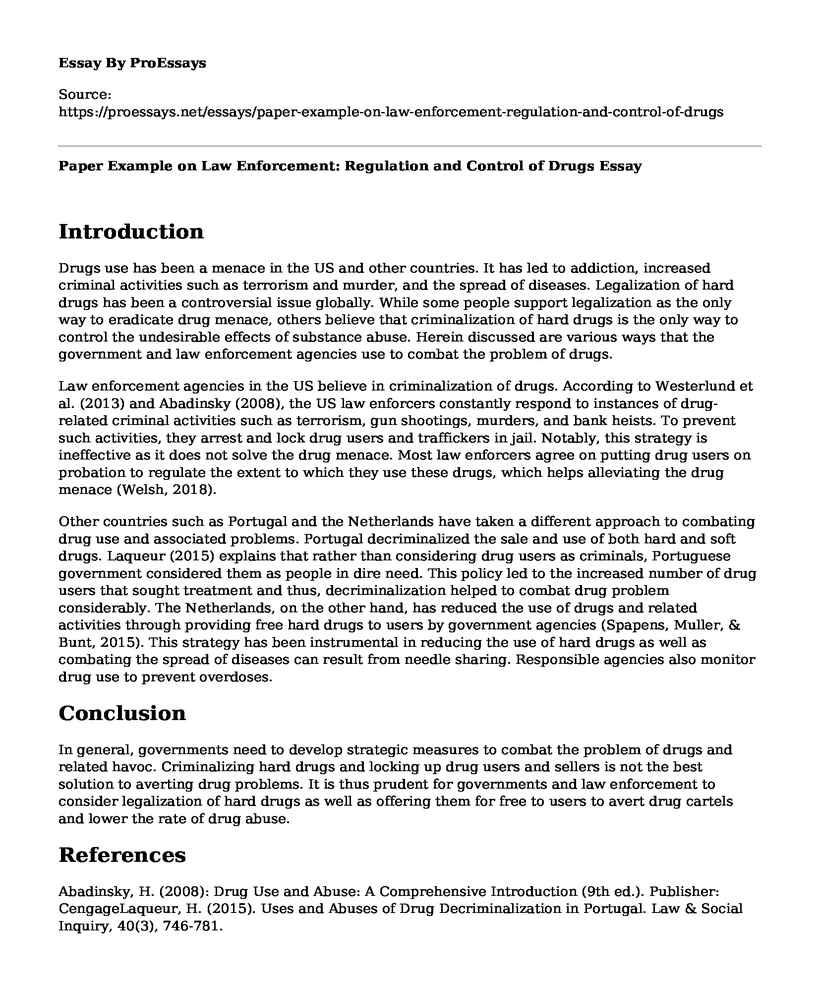Introduction
Drugs use has been a menace in the US and other countries. It has led to addiction, increased criminal activities such as terrorism and murder, and the spread of diseases. Legalization of hard drugs has been a controversial issue globally. While some people support legalization as the only way to eradicate drug menace, others believe that criminalization of hard drugs is the only way to control the undesirable effects of substance abuse. Herein discussed are various ways that the government and law enforcement agencies use to combat the problem of drugs.
Law enforcement agencies in the US believe in criminalization of drugs. According to Westerlund et al. (2013) and Abadinsky (2008), the US law enforcers constantly respond to instances of drug-related criminal activities such as terrorism, gun shootings, murders, and bank heists. To prevent such activities, they arrest and lock drug users and traffickers in jail. Notably, this strategy is ineffective as it does not solve the drug menace. Most law enforcers agree on putting drug users on probation to regulate the extent to which they use these drugs, which helps alleviating the drug menace (Welsh, 2018).
Other countries such as Portugal and the Netherlands have taken a different approach to combating drug use and associated problems. Portugal decriminalized the sale and use of both hard and soft drugs. Laqueur (2015) explains that rather than considering drug users as criminals, Portuguese government considered them as people in dire need. This policy led to the increased number of drug users that sought treatment and thus, decriminalization helped to combat drug problem considerably. The Netherlands, on the other hand, has reduced the use of drugs and related activities through providing free hard drugs to users by government agencies (Spapens, Muller, & Bunt, 2015). This strategy has been instrumental in reducing the use of hard drugs as well as combating the spread of diseases can result from needle sharing. Responsible agencies also monitor drug use to prevent overdoses.
Conclusion
In general, governments need to develop strategic measures to combat the problem of drugs and related havoc. Criminalizing hard drugs and locking up drug users and sellers is not the best solution to averting drug problems. It is thus prudent for governments and law enforcement to consider legalization of hard drugs as well as offering them for free to users to avert drug cartels and lower the rate of drug abuse.
References
Abadinsky, H. (2008): Drug Use and Abuse: A Comprehensive Introduction (9th ed.). Publisher: CengageLaqueur, H. (2015). Uses and Abuses of Drug Decriminalization in Portugal. Law & Social Inquiry, 40(3), 746-781.
Spapens, T., Muller, T., & Bunt, H. (2015). The Dutch Drug Policy from a Regulatory Perspective. European Journal On Criminal Policy & Research, 21(1), 191.
Welsh, B. (2018). Costs and benefits of preventing crime. Routledge.Westerlund, T., Gelin, U., Pettersson, E., Skarlund, F., Wagstrom, K., & Ringbom, C. (2013). A retrospective analysis of drug-related problems documented in a national database. International journal of clinical pharmacy, 35(2), 202-209.
Cite this page
Paper Example on Law Enforcement: Regulation and Control of Drugs. (2022, Jul 21). Retrieved from https://proessays.net/essays/paper-example-on-law-enforcement-regulation-and-control-of-drugs
If you are the original author of this essay and no longer wish to have it published on the ProEssays website, please click below to request its removal:
- Intelligence Process in Immigration for Canada Paper Example
- Cybercrime: Local to Global Essay Example
- Testing on Human Vs Testing on Animals Essay Example
- Essay Sample on The Role of Courts in Our World
- Essay on Youthful Incarceration: Detention, Boot Camps & Community Service
- Paper Example on Appellant Fails to Convict of 1st Degree Murder in Supreme Court
- Offenders in Jails - Report Example







